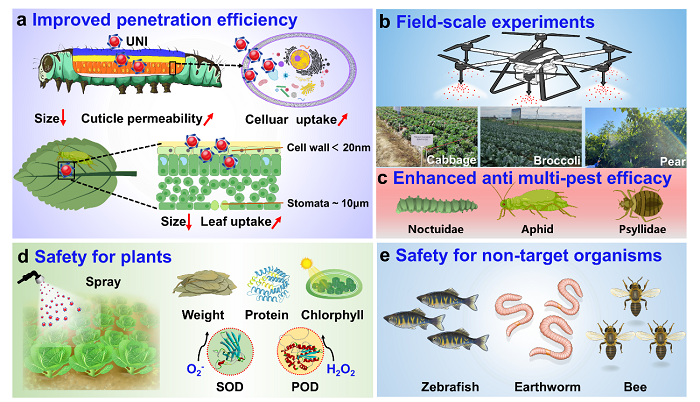The Multifunctional Nanomaterials and Agricultural Applications Innovation Team at the Institute of Environment and Sustainable Development in Agriculture (IEDA), Chinese Academy of Agricultural Sciences, successfully developed a green water-based unimolecular nanopesticide delivery system. The system has solved the problem of small-sized dispersion and delivery of insoluble pesticides in aqueous solutions, and the unimolecular nanopesticides developed have enabled efficient and green pest control on multiple crops. Meanwhile, the team systematically elucidated the self-assembly mechanism of pesticidal carriers and their key interactions, providing a fresh perspective and technical route for transforming insoluble pesticides toward water-based unimolecular dispersion. The related findings have been published in Nature Communications.

Nanopesticides provide immerse potential in reducing pesticide use and promoting sustainable agriculture. Nanopesticides can effectively enhance pesticide penetration into both insects and leaves through their unique nanoproperties, in particular their small size. However, it remains a great challenge to achieve unimolecular formulations in water-based processes in order to take full advantages of nanoproperties. Using ionic liquid, the study fabricated unimolecular nanopesticides in a water-based process. The system significantly enhanced cellular uptake, insect-dermis translocation, and leaf-cuticle penetration of pesticides, improved the release, diffusion and leaf surface deposition of pesticides, and enhanced field efficacy against multiple pests. The unimolecular nanopesticide system represents a water-based and facile-manufactured platform for insoluble pesticides, providing new insights into green and low-carbon agricultural production, efficient resource utilization and environmental sustainability in China.
IEDA is the sole corresponding affiliation of the paper, Dr. Li Xingye is the first author and Prof. Wang Yan, Chief Scientist of the team, is the corresponding author. This study was supported by the National Key R&D Program of China, the National Natural Science Foundation of China and the Agricultural Science and Technology Innovation Program.
Linkage: https://doi.org/10.1038/s41467-025-61969-7

